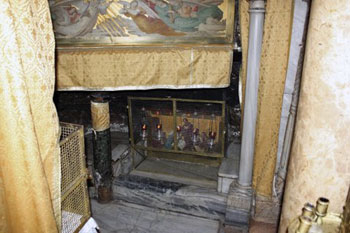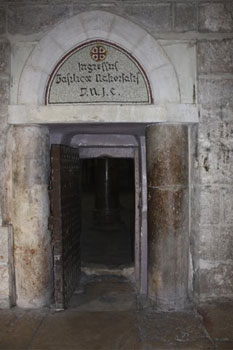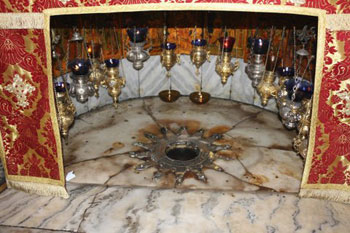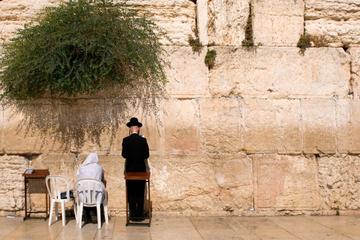
Bethlehem, Palestine
by Troy Herrick
Set on the edge of a hill in the little town of Bethlehem, the gray stone Basilica of the Nativity is built over a cave housing the traditional site of Jesus’ birth. Divided between the Greek Orthodox, Roman Catholic and Armenian Churches, the layout of the present structure is as complex as the relationships between the three Christian sects. Tension is always in the air and the slightest incident, like adjusting another’s candlestick, can have major ramifications; and the respective clergy does not turn the other cheek. Fights have even been recorded.
 St. Helena, the mother of the Roman Emperor Constantine, commissioned this basilica in the 4th century CE. Over a century later in 565 CE, the Byzantine Emperor Justinian rebuilt this structure after a Samaritan uprising destroyed it. Add some images from the Crusader Period and you find a hodgepodge of the ages. Even with the past renovations and upgrades, the Basilica of the Nativity remains the oldest continuously operating church in the Holy Land. Your tour begins outside the front door.
St. Helena, the mother of the Roman Emperor Constantine, commissioned this basilica in the 4th century CE. Over a century later in 565 CE, the Byzantine Emperor Justinian rebuilt this structure after a Samaritan uprising destroyed it. Add some images from the Crusader Period and you find a hodgepodge of the ages. Even with the past renovations and upgrades, the Basilica of the Nativity remains the oldest continuously operating church in the Holy Land. Your tour begins outside the front door.
The Basilica of the Nativity
 As I strained to enter the basilica through the main door, I suddenly remembered the parable of the camel and the eye of a needle (Matthew 19:24). Known as the “Door of Humility”, the main entrance measures a mere 0.2 by 0.4 square meters. Why would the second holiest site in Christendom require such a small door? Cynics might think that it was to prevent the congregation from exiting en mass during a boring sermon; but actually this centuries-old door was designed to prevent looters from loading up wagons with ill-gotten gains.
As I strained to enter the basilica through the main door, I suddenly remembered the parable of the camel and the eye of a needle (Matthew 19:24). Known as the “Door of Humility”, the main entrance measures a mere 0.2 by 0.4 square meters. Why would the second holiest site in Christendom require such a small door? Cynics might think that it was to prevent the congregation from exiting en mass during a boring sermon; but actually this centuries-old door was designed to prevent looters from loading up wagons with ill-gotten gains.
As you straighten up, you find yourself in a nave filled with 44 polished reddish white limestone Corinthian columns from the original 4th century CE structure, organized into four rows. The faded images of saints, painted during the Crusader Period, adorn the upper sections of each column. Unfortunately the poor lighting obscures some of these images. Tension between the three Christian sects has prevented their restoration. Another trace of the original church is the mosaic floor now hidden beneath a trap door. Feel free to take a look at the bird, flower and vine patterns.
The Altar of the Nativity at the front of the church, belonging to the Greek Orthodox Church, is decorated with angels and icons. This high altar is set directly above the traditional spot of Jesus’ birth in the Grotto of the Nativity below. You visit the grotto by descending the stairways on either side of the altar.
The Grotto of the Nativity
 The Grotto of the Nativity has been hewn into the bedrock. I was somewhat taken aback upon entering this cave because the Gospel of Matthew indicates that the three wise men came into a house (Matthew 2:11) not a cave. Apparently the new parents lived as troglodytes during their stay in Bethlehem.
The Grotto of the Nativity has been hewn into the bedrock. I was somewhat taken aback upon entering this cave because the Gospel of Matthew indicates that the three wise men came into a house (Matthew 2:11) not a cave. Apparently the new parents lived as troglodytes during their stay in Bethlehem.
Visitors find several sacred spots inside the grotto. The most important of these is a raised marble platform with a fourteen-point silver star. The Latin inscription on the star identifies this as the spot where Mary gave birth to Jesus.
The nearby Chapel of the Manger has a white marble trough, set under the altar, as its focal point. This marks the spot where the original, now long gone, manger was situated (Luke 2:7). Visitors should note that the Gospels do not mention that farm animals were present at the Nativity. This inference likely arises because a manger is usually associated with farm animals. Perhaps the manger was moved into the house away from the farm animals?
 A narrow hallway leads you from the grotto to two other notable chapels related to the Nativity story. The Chapel of the Innocents commemorates the children slain by King Herod’s soldiers who were trying to locate the infant Jesus (Matthew 2:16-18); and the nearby Chapel of St Joseph is dedicated to the angel appearing to Joseph in a dream and directing him to flee to Egypt with his family (Matthew 2:13).
A narrow hallway leads you from the grotto to two other notable chapels related to the Nativity story. The Chapel of the Innocents commemorates the children slain by King Herod’s soldiers who were trying to locate the infant Jesus (Matthew 2:16-18); and the nearby Chapel of St Joseph is dedicated to the angel appearing to Joseph in a dream and directing him to flee to Egypt with his family (Matthew 2:13).
Observant visitors will find a heavy wooden door with a peep hole in the hallway near the Chapel of the Innocents. At the height of the tension between the three Christian sects, this door was locked thereby barring Roman Catholics from visiting the Greek Orthodox shrine in the grotto.
Your next destination is the Church of St. Catherine set above these two chapels. Ascend the stairs near the Chapel of St. Joseph and find yourself just inside of the front door of the church.
The Church of St. Catherine
 Built in 1861, the Roman Catholic Church of St. Catherine adjoins the basilica. This church commemorates Christ’s appearance to St Catherine of Alexandria. Jesus warned Catherine of her impending martyrdom in 310 CE. At the front of the church, the high altar is situated over the Chapel of the Innocents.
Built in 1861, the Roman Catholic Church of St. Catherine adjoins the basilica. This church commemorates Christ’s appearance to St Catherine of Alexandria. Jesus warned Catherine of her impending martyrdom in 310 CE. At the front of the church, the high altar is situated over the Chapel of the Innocents.
The church boasts a bas-relief of the Tree of Jesse outlining Jesus’ lineage from Abraham to Joseph. The upper portion of the bas-relief depicts Christ blessing the earth. Pope Benedict XVI gifted this bas-relief during his visit to the Holy Land in 2009.
When you complete your visit, exit the church complex and cross the road to Manger Square. Lining the periphery of the square is a number of shops where you can look for that perfect souvenir of your visit to Bethlehem. After purchasing our souvenir, it was time for Diane and me to return to Jerusalem because there was no room at the inn.

Private Full-Day Tour of Jerusalem and Bethlehem
If You Go:
Bethlehem is in the West Bank and controlled by the Palestinian Authority. To visit this city you have the option of traveling alone using bus #21, departing from the Arab bus station near the Damascus Gate in Jerusalem, to Bethlehem. Alternatively you can take a Bethlehem City Tour with a Palestinian tour guide. I recommend Green Olive Tours.
Remember to bring your passport with you in order to pass through the Israeli military checkpoint.
Admission to the Church of the Nativity is free.
You are invited to visit my Israel webpage. www.plan-a-dream-trip.com/travel-to-israel.html
About the author:
Troy Herrick, a freelance travel writer, has traveled extensively in North America, the Caribbean, Europe and parts of South America. His articles have appeared in Live Life Travel, International Living, Offbeat Travel and Travels Thru History Magazines. He also penned the travel planning e-book entitled ”Turn Your Dream Vacation into Reality: A Game Plan for Seeing the World the Way You Want to See It” – www.thebudgettravelstore.com/page/76972202 based on his own travel experiences over the years. Plan your vacation at his www.thebudgettravelstore.com and his www.plan-a-dream-trip.com sites.
Photo credits:
All photographs are by Diane Gagnon. She is a freelance photographer who has traveled extensively in North America, the Caribbean, Europe and parts of South America. Her photographs have accompanied Troy Herrick’s articles in Live Life Travel, Offbeat Travel and Travel Thru History Magazines.



Leave a Reply
You must be logged in to post a comment.